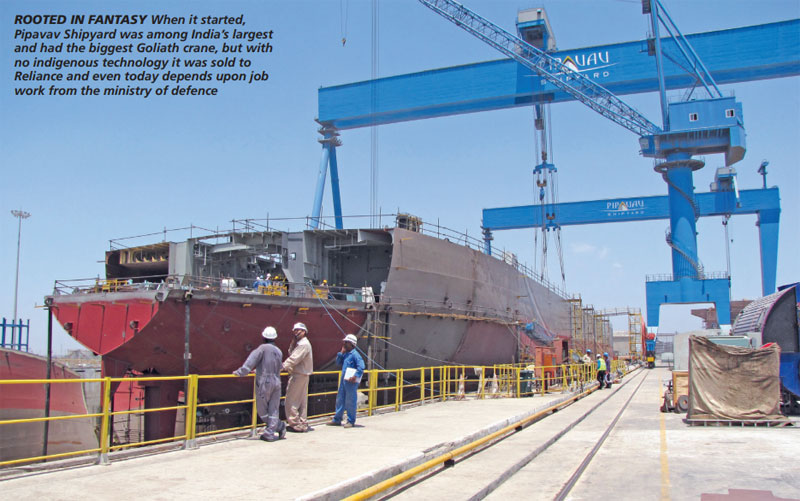India’s indigenous shipbuilding industry needs more than just an ambition
Mohammad Asif Khan
At the inauguration ceremony of the Global Maritime Summit in Mumbai on 17 October 2023, Prime Minister Narendra Modi highlighted India's ambitions in the naval shipbuilding sector. He said, “INS Vikrant is proof of India’s shipbuilding capacity. India will become one of the top five naval shipbuilding nations in the coming decade. Our mantra is ‘Make in India, Make for the World’. The government is working to bring together all stakeholders in the sector through maritime clusters. Naval shipbuilding and repair centres will be developed at many places.”

India’s ambition to become a significant player in global naval shipbuilding is evident, yet the reality presents numerous challenges. As of 2024, India accounts for a modest share of the global naval shipbuilding industry, trailing far behind leaders like the United States, China and Russia. The country has several shipyards, with only a handful under the central public sector and state governments, and the majority in the private sector. Indian naval shipyards contribute to a relatively small portion of the global naval shipbuilding capacity, hindered by high financing costs, bureaucratic inefficiencies and the smaller scale of operations. This makes it challenging to compete with larger international players on price and efficiency.
The decline in India’s global naval shipbuilding market share from the early 2000s to its current state can be attributed to several factors. A significant challenge has been the difficulty in securing large international orders and the heavy reliance on imported materials, which make up about 65 per cent of the inputs for naval shipbuilding. Moreover, the proportion of India’s indigenous naval fleet involved in strategic and defensive operations remains limited. To address these issues, the Indian government has introduced initiatives like the Shipbuilding Financial Assistance Policy and Maritime Vision 2030 to revitalise the industry and boost competitiveness.
Missed Opportunities: India’s journey in the naval shipbuilding industry has been marked by significant milestones and missed opportunities. In 2014, when Prime Minister Modi assumed office, there was a palpable momentum to establish India as an important player in the global naval shipbuilding market. However, several initiatives faced significant hurdles. A decade later, the scenario appears more promising but is still fraught with challenges.
Policy and Its Efficacy: India has introduced several policies to boost domestic naval shipbuilding. These include the Defence Procurement Procedure (DPP) and the Strategic Partnership (SP) model. The DPP emphasises the importance of indigenisation, aiming to reduce dependence on imports. The SP model fosters long-term collaborations with private sector firms to improve domestic naval shipbuilding capabilities.
Despite these initiatives, the industry faces significant challenges, including bureaucratic hurdles and slow implementation. For instance, the Indigenous Aircraft Carrier (IAC-1) project, initiated in 2009, has experienced considerable delays and cost overruns. Moreover, the financial assistance scheme for shipbuilders, introduced in 2016, has been a subject of contention. While the scheme offers a sliding scale of financial aid, starting at 20 per cent and gradually reducing to 11 per cent over ten years, it has been criticised for its limited scope and lack of impact. Industry experts argue that the assistance primarily covers duties and taxes rather than providing a level playing field against heavily subsidised global competitors like China and Russia. The latter nations not only offer substantial financial incentives but also benefit from economies of scale and advanced technologies, making it difficult for Indian shipyards to compete on cost and quality.
Vision for 2047
Indian Navy Chief Admiral R Hari Kumar has laid out a vision for 2047 that involves achieving full indigenisation of all naval platforms, including ships, submarines, aircraft and unmanned systems. Project 75I, which aims to build six advanced submarines with air-independent propulsion systems, is a critical step toward this goal. However, the project has encountered delays due to procedural issues and complexities related to technology transfer. This highlights the need for effective project execution and streamlined procurement processes.
Maritime India Vision 2030 sets ambitious targets, aiming to move India's naval shipbuilding and repair ranking to the top 10 globally. By 2047, the Maritime Amrit Kaal Vision seeks to elevate India to the top five. To meet these targets, the annual output of Indian shipyards must significantly increase, according to KPMG. Currently, Indian-owned and flagged naval vessels account for only a limited portion of the country's strategic and defensive capabilities.
You must be logged in to view this content.

